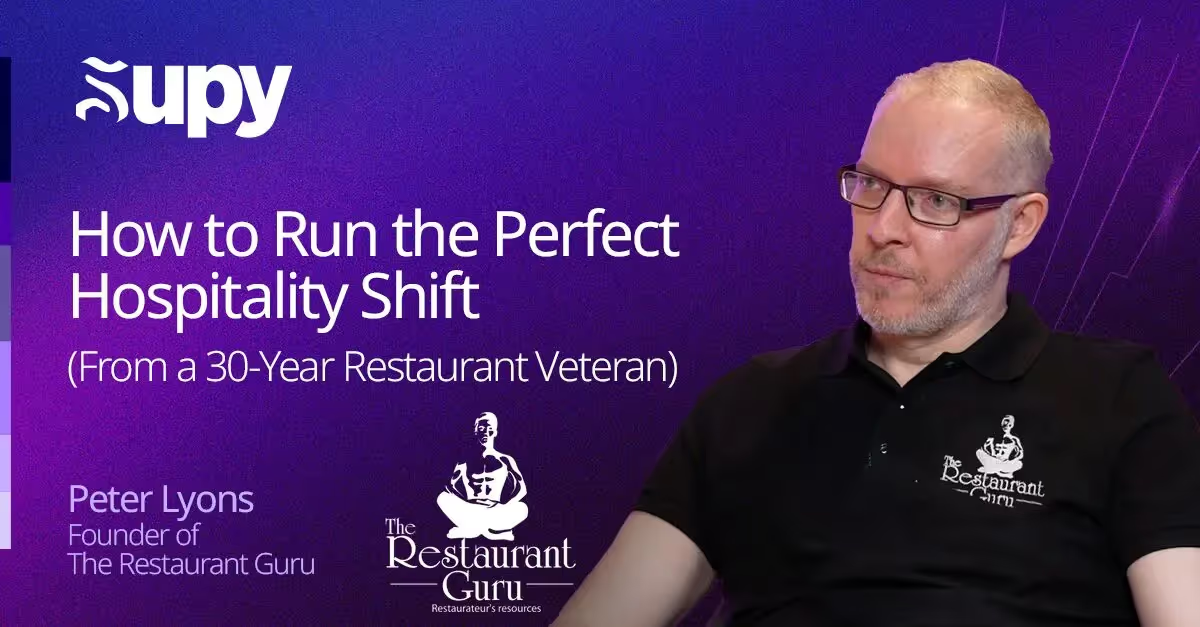How to Run the Perfect Hospitality Shift (From a 30-Year Restaurant Veteran)

By Peter Lyons, Founder of The Restaurant Guru
Why this matters
A great guest experience doesn’t just happen. It’s planned. And it starts long before the doors open.
If you’re winging your way through each shift - hoping the team’s in a good mood and the numbers fall into place - you’re leaving money, morale, and margin on the table.
In this article, I’ll walk you through how to structure the perfect hospitality shift from start to finish - no fluff, just practical strategy that works.
And if you want a simple way to put this into action using the exact format I’ve used across dozens of teams click below to download.
Think like the military
I wasn’t in combat, but my time in the Air Force cadets shaped how I think about structure and operations. Every mission had a goal, a plan, a debrief.
Your hospitality shift should be no different.
Here’s how I break it down:
- The P&L = The War
- Each Month = A Battle
- Each Shift = A Mission
You don’t win the war by accident. You win it one mission at a time - with strategy, structure, and clear leadership.
Step-by-step: Running a world-class shift
1. Before the shift: Set the strategy
Start with your numbers. Know your revenue target for the day, and break it down into:
- Per shift
- Per server
- Spend per head (SPH) goal
Example:
- Target: $10,000
- 5 servers on shift = $2,000 each
- Forecast: 100 covers = $100 SPH
Now communicate it. In the pre-shift meeting, which should last 2–5 minutes:
- Share the day’s goal
- Break it down visually (use a big calculator or whiteboard)
- Ask the team: “How are you going to hit that?”
- Make it interactive - mini quiz, upsell challenges, etc.
This isn’t about pressure. It’s about ownership.
2. During the shift: Lead the energy
Here’s where managers make or break the shift.
The job isn’t just to “supervise.” It’s to set the tone, coach in the moment, and manage the flow of information and energy.
- Use slow moments for 5-minute refreshers: latte art, upselling side dishes, objection handling
- Observe service - praise what’s right, correct with kindness
- Run live incentives to boost morale (see gamification tip below)
3. Add gamification to keep things fun
Want to push a slow-moving menu item? Try this:
- Start with a small prize (e.g. $10 note)
- Every time someone sells that item (say, garlic bread), the note passes to them
- Ring a bell at a random time during the shift - whoever has the note wins it
It keeps energy high, encourages focus, and adds a dose of fun. Far better than tired old leaderboards.
4. End the shift with a 2-minute wrap
Don’t just send them home - close the loop.
- Celebrate wins: “We hit 9.6k - amazing job team.”
- Acknowledge effort: “Great work on the upsells today.”
- Set the tone for tomorrow
Even if you had a rough shift, end on a clear and constructive note. That’s what keeps morale steady.
The payoff
When you run a shift with this level of structure and intention:
- Staff feel focused and supported
- Managers lead instead of firefight
- Guests feel the difference - and come back
- Revenue targets are no longer guesses - they’re goals
Action steps for operators
Here’s how to apply this shift strategy today:
✅ Download our shift briefing template
- Include today’s revenue goal, team on shift, forecasted covers
- Break down spend-per-head target
- Add one key focus (upsell, smiles, service speed)
✅ Train managers to run pre- and post-shift meetings
- Short, sharp, energetic
- Visual and interactive - not lectures
- Use the same format every day to build habit
✅ Introduce a live incentive once a week
- Pick one item to push
- Use gamification to boost sales and morale
- Keep prizes small but meaningful (cash, coffee vouchers, early finish)
✅ Run a daily micro-training
- 3–5 minutes max
- Rotate focus: menu knowledge, guest recovery, product quality
- Make it informal - real-world coaching, not classroom
Helpful next steps
Want to standardise your operations without losing the magic? These tools can help:
- Shift Briefing Template from The Restaurant Guru's toolkit
Book a Demo with Supy — see how our platform helps you track targets, stock, and performance across every shift
Final Thoughts: From Chaos to Clarity
Issue: Many restaurants treat the shift as a reactive scramble rather than a structured operation.
Lesson: A well-run shift starts before service begins. Pre-shift planning, goal setting, and team communication turn every shift into a high-performance window.
Result: Operators who adopt this approach report stronger team morale, higher sales per head, and fewer mid-shift surprises.
What’s Next?
If you’re facing challenges in your daily operations or want help building a framework that works for your business:
Download the free Shift Briefing Template and start using it today
Book a demo with Supy to see how the right tools support better execution
Reach out to Pete Lyons for a no-obligation conversation about your operational pain points.
UK +44 7961 911 785
UAE +971 56 707 8306
Founder@therestaurantguru.com
www.therestaurantguru.com







